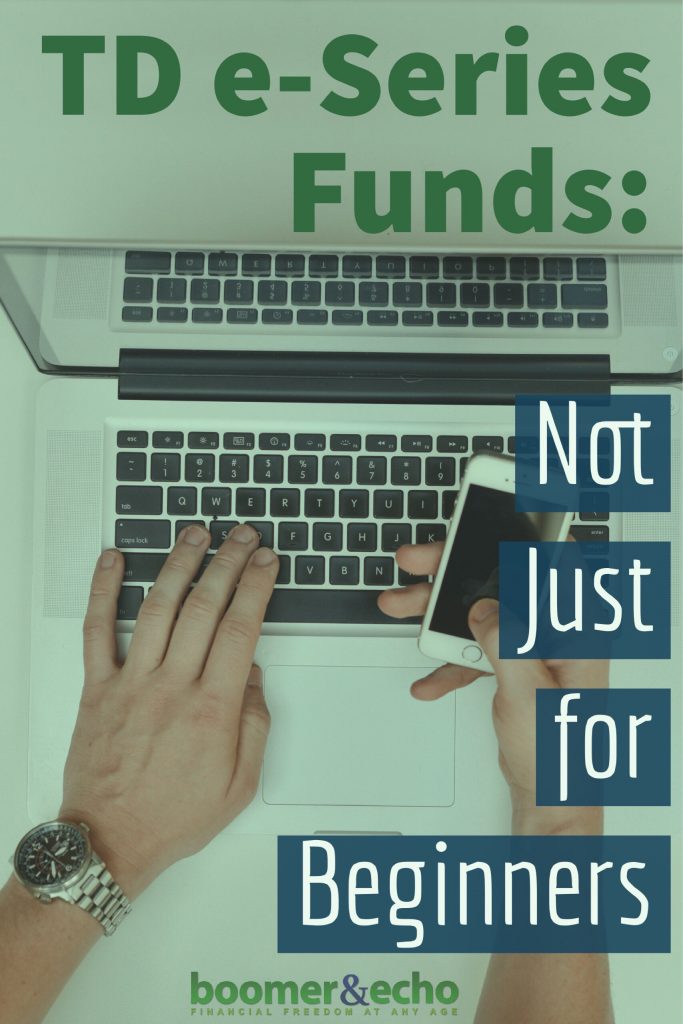In a recent Carrick Talks Money video series on the Globe and Mail, Rob Carrick discussed the “I’m finally ready to invest” portfolio for young adults. He asked Canadian Couch Potato blogger Dan Bortolotti, and PWL Capital wealth manager Justin Bender to come up with a portfolio of exchange traded funds (ETFs) for the young investor who’s just starting out. They came up with a better and simpler approach using TD e-Series funds:
Related: How index funds compare with equity mutual funds
TD e-Series Funds
You can build a low cost, broadly diversified portfolio with just four index funds from the TD e-Series family. Just use this simple asset allocation:
| Fund type | Fund name | Allocation | Expense Ratio |
| Canadian Equity | TD Canadian Index – e | 25% | 0.33% |
| US Equity | TD US Index – e | 25% | 0.35% |
| International Equity | TD International Index – e | 25% | 0.50% |
| Canadian Bonds | TD Canadian Bond Index – e | 25% | 0.51% |
The strategy is touted as a good option for beginners because it gives investors a simple way to set-up a low-cost, broadly diversified portfolio.
Unfortunately, the “lack of sophistication” with this simple portfolio turns off a lot of investors who may feel the need to spice things up to get better returns, better diversification, or lower costs.
My argument is that TD e-Series funds are not only good for beginners but they can be useful all throughout your investing life.
Related: How not to start investing
“A portfolio of e-Series funds is almost certainly better than what 90 percent of Canadian investors have now,” said Bortolotti.
The main problem, as he sees it, is behavioural. People are surprisingly resistant to simple solutions.
Simple doesn’t mean stupid
The other obstacle is that some people still can’t get past the idea that mutual funds are for chumps and ETFs are for sophisticated investors. It seems like many investors think once you reach $50,000 or so that you must then “graduate” to a more sophisticated portfolio. Clearly that’s not the case.
“I have heard from dozens of investors who have successfully used the e-Series funds for years, but they’re itching to “move up” to ETFs, as though it’s some kind of promotion,” said Bortolotti.
He says mutual funds are actually superior to ETFs in many ways: more user-friendly, no commissions to buy or sell, no bid-ask spreads, ability to set up automatic contributions, and automatic reinvestment of dividends. These advantages tend to be overlooked by investors who zero in on management expense ratios (MERs) as if they are the only factor to consider.
Related: Are mutual funds really that bad?
“We’ve used the e-Series funds for several of our DIY clients, even for portfolios as large as $300,000 or so,” he said.
A couple recently profiled in MoneySense magazine had about $140,000 to invest and wanted to consolidate their current portfolios of individual stocks, actively managed mutual funds, and index funds into one simple and low cost solution.
Dan Hallett was the advisor quoted in the article and he recommended using TD e-Series funds:
“They’re ideal because they’re almost as cheap as ETFs but you don’t need to pay brokerage fees, you can invest to the penny, every cent of distributions can compound through a full reinvestment and they’re ideal for those making regular deposits.”
The Global Couch Potato – which can easily be built with e-Series funds – did almost as well as the more complex portfolios over 10- and 20-year periods.

Why are they so hard to buy?
The biggest knock against TD e-Series funds is how much of a pain it is to get them set up. The funds are called e-Series because you can only buy them online, but you can’t actually open the account online because the bank requires your signature. That means visiting a branch; where there’s a good chance the bank representatives won’t know how to help you set them up. See this recent thread posted in the Canadian Money Forum.
Speaking from personal experience, I didn’t have any trouble buying TD e-Series funds – but that may just be because I’m already a TD customer. You can read more about e-Series funds here, including how to set them up and what type of funds TD offers.
Final thoughts
I use e-Series funds for my kids’ RESP account and contribute $200 to one of the four funds each month. To rebalance the portfolio back into its original asset allocation, I’d simply buy more of the lower valued fund until it got back up to 25 percent.
The bottom line: TD e-Series funds are not just for beginners. If you want a simple, low-cost, broadly diversified portfolio, e-Series funds are definitely worth a look.